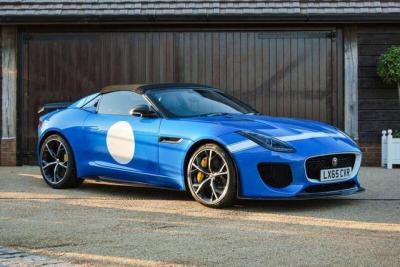Categories ▼
Counties▼
ADS » WARWICKSHIRE » WARWICK » VEHICLES AND PARTS » #37930
This lot will be auctioned via Iconic Auctioneers, Race Retro Collectors' Car Sale 2024 on Saturday the 24th of February, Stoneleigh Park, Stoneleigh Rd, Coventry, CV8 2LG. , In 2012, nearly 40 years after the E-Type's demise, Jaguar finally got around to announcing the long-awaited and much-rumoured F-Type, which would turn out to be a more worthy spiritual successor to its illustrious forbearer than either the preceding XK8 or, before that, the XJS. A front-engined, rear-wheel-drive two-seater, the F-Type is built on an aluminium chassis, cleverly configured to minimise the transmission of noise and vibration to the passenger compartment, while its suspension is the supercar-standard arrangement of double wishbones all round, with adaptive dampers and adjustable settings. Multiple driving modes cater for different road conditions and driving styles.Unlike the E-Type, the F-Type was available with a wide variety of different power plants, ranging from a turbocharged 2-litre four via a 3-litre turbo V6 to a supercharged 5.0-litre V8. A ZF 8-speed paddle-shift semi-automatic transmission was standard on all models at first, with a 6-speed manual available later on the V6. The F-Type debuted at the Paris Motor Show in September 2012 in convertible form, with the fixed-head coupé following in 2014. Nowadays it is de rigeur for car stylists to reference past models in their latest creations, and to some observers, the coupé's rear recalled that of one of the rarest of E-Types: the low-drag factory racer.To cater for the sports car market's seemingly insatiable appetite for limited edition models, Jaguar launched the 400 Sport – produced for just one year – and Project 7, which would be built in a run of only 250 cars. Project 7 had first seen the light of day as a single-seater concept car shown at Goodwood, and so favourable was the reception that it was decided to press ahead with making a more practical two-seater production version. They soon sold out, with 80 assigned to customers in the UK. The 'Project 7' designation referenced Jaguar's seven Le Mans wins, while the 'Aero Haunch' behind the driver's head was an obvious nod towards the D-Type sports-racer responsible for three of those victories.An aggressive-looking shallow-screen 'barchetta', Project 7 has all-aluminium bodywork and is powered by the 5-litre supercharged V8, up-rated to produce 567bhp, 25bhp more than in the F-Type R. Coupled with a 45kg weight reduction, this makes Project 7 the fastest accelerating F-Type yet, with a 0-60mph (0-97km/h) time of 3.8 seconds. Like many of the current crop of supercars, Project 7 is electronically limited to a top speed of 186mph (300kph). With the exhaust butterflies open (there's a special console switch), the car emits a superb growl-bark that turns into a magnificent crackle on the overrun. It's the one thing that makes you want to slow down.The 'top-end running gear' includes the 8-speed paddle-shift auto 'box; electronic differential; carbon ceramic brakes; specially tuned suspension; and unique settings for engine management and chassis stability control. SVO engineers also rebalanced and improved the car's rear-biased aerodynamic downforce by fitting side skirts and a large front splitter, while slightly reducing the effectiveness (and drag) of the boot lid wing. The result of Project 7's unique set of characteristics is a track-focused car capable of satisfying even the quickest of drivers.Full details to follow soon.
Central Locking; Electronic Stability Program (ESP); Power-assisted Steering (PAS); Previously Registered Overseas; Safety Belt Pretensioners
Posted 22/01/24, views 2
Contact the advertiser:


